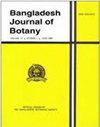Assessment of soil quality in hanzhong city based on risk management of heavy metal pollution
IF 0.4
4区 生物学
Q4 PLANT SCIENCES
引用次数: 0
Abstract
In the present study, Hanzhong City was taken as an example, and the classification of soil heavy metal pollution risks was performed based on the evaluation of soil fertility status with soil physical and chemical properties as the main indicators. Results showed that the coefficients of variation of soil physical and chemical indicators in the study area were in the descending order: the soil fertility status showed a trend of increasing with decreasing terrain and increasing rivers. The high fertility areas were mainly distributed in the northwest and northeast of the plain area, while the low fertility areas were mainly distributed in the southeastern hilly and mountainous areas and in the western low-lying areas, and the transitional areas surrounded the low-fertility areas. At least 88.89% of the Cd samples and 98.61% of the Cr samples out of the eight heavy metals, Cd, Hg, As, Pb, Cr, Ni, Cu, and Zn, belonged to the priority protection class, while 11.11% of the Cd samples and 1.39% of the Cr samples belonged to the safe use class. The overall distribution of soil quality was similar to that of soil fertility status, while the distribution range of low-quality soil in the southeastern part was smaller and more concentrated. The above research results indicate that the introduction of the classification results of soil pollution risk control types generally reduces the soil fertility status correction and changes the spatial distribution pattern of the original soil fertility status to some extent. Bangladesh J. Bot. 52(2): 659-669, 2023 (June) Special基于重金属污染风险管理的汉中市土壤质量评价
本研究以汉中市为例,以土壤理化性质为主要指标,在评价土壤肥力状况的基础上进行土壤重金属污染风险分级。结果表明:研究区土壤理化指标的变异系数呈递减趋势,土壤肥力状况随地形的减少和河流的增加而增加;高肥力区主要分布在平原区的西北部和东北部,低肥力区主要分布在东南部丘陵山区和西部低洼地区,以及低肥力区周围的过渡区。Cd、Hg、As、Pb、Cr、Ni、Cu、Zn 8种重金属中,至少88.89%的Cd样品和98.61%的Cr样品属于优先保护类,11.11%的Cd样品和1.39%的Cr样品属于安全使用类。土壤质量总体分布与土壤肥力状况相似,但东南部低质量土壤分布范围较小且较为集中。上述研究结果表明,土壤污染风险控制类型分类结果的引入,总体上降低了土壤肥力状态校正,并在一定程度上改变了原有土壤肥力状态的空间分布格局。中国生物医学工程学报,52(2):659-669,2023(6):特刊
本文章由计算机程序翻译,如有差异,请以英文原文为准。
求助全文
约1分钟内获得全文
求助全文
来源期刊

Bangladesh Journal of Botany
生物-植物科学
CiteScore
0.80
自引率
0.00%
发文量
77
审稿时长
9 months
期刊介绍:
Bangladesh in situated on the north of Bay of Bengal. Climatically it is a humid subtropical country. Most of the land is deltaic plain of two great rivers, the Ganges and the Bhrammaputra and it tributaries. The country has rich diversity of plants. Main crops cultivated are Rice, Jute, Wheat, Maize, Sugarcane, Mustard and different kinds of Lentils. There are a good number of Public and Private Universities and Plant Research Establishments.
Bangladesh Journal of Botany is the official organ of the Bangladesh Botanical Society established in 1972. Since 1972 Bangladesh Journal of Botany is being published regularly. Two issues of the Journal are published, one in June and another in December.
Scientific papers (Full paper and short communication) on any field of Plant Sciences from anywhere in the World are considered for publication in Bangladesh Journal of Botany.
 求助内容:
求助内容: 应助结果提醒方式:
应助结果提醒方式:


